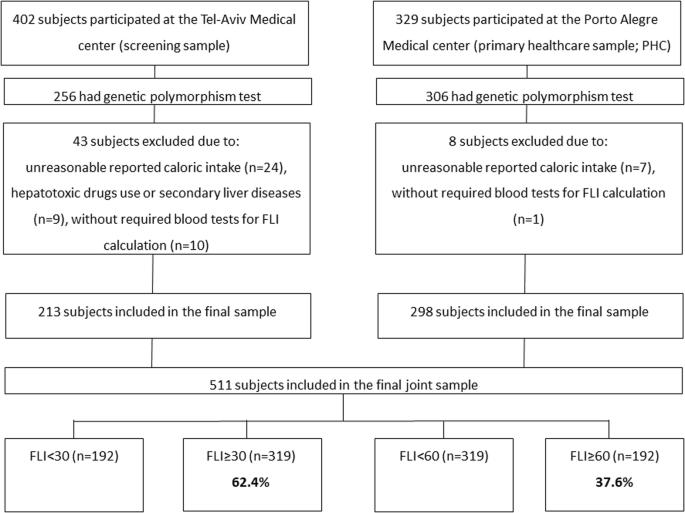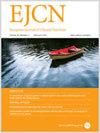在一项多中心横断面研究中,PNPLA3多态性携带者食用大量红肉与非酒精性脂肪肝有关。
IF 3.6
3区 医学
Q2 NUTRITION & DIETETICS
引用次数: 0
摘要
背景与目的:含类磷脂酶结构域的 Patatin-like phospholipase domain-containing 3 基因(PNPLA3)多态性与非酒精性脂肪肝(NAFLD)的易感性有关,有证据表明可能与营养相互作用。然而,肉类消费与基因多态性的结合尚未得到检验。因此,本研究旨在检测在肉类消费多样化的人群中,PNPLA3 rs738409 G-等位基因与高肉类消费和非酒精性脂肪肝之间的关联:在以色列筛查人群和巴西初级保健人群中进行横断面研究。食物消费量通过食物频率问卷进行评估。PNPLA3多态性被定义为同卵(GG)或异卵(GC)。脂肪肝指数(FLI)≥30为不确定/可能的非酒精性脂肪肝,FLI≥60为可能的非酒精性脂肪肝:样本包括来自筛查人群和初级保健人群的 511 名受试者(分别为 213 人和 298 人)。基因多态性(同基因 GG 或杂基因 GC)与总肉类、红肉和/或加工肉类、未加工红肉和加工肉类的高消费量相关,与不确定/可能的非酒精性脂肪肝的最高几率相关(OR = 2.75,95%CI 1.27-5.97, p = 0.011; OR = 3.24, 1.43-7.34, p = 0.005; OR = 2.92, 1.32-6.47, p = 0.008; OR = 3.16, 1.46-6.83, p = 0.003)。此外,基因多态性与高加工肉类摄入量相关,可能患非酒精性脂肪肝的几率最高(OR = 2.40,95%CI 1.04-5.56,p = 0.040):结论:PNPLA3多态性携带者摄入大量红肉可能会增加非酒精性脂肪肝的风险。需要进行前瞻性研究来证实这些发现,并考虑尽量减少PNPLA3多态性携带者食用红肉和加工肉类。本文章由计算机程序翻译,如有差异,请以英文原文为准。


High red meat consumption among PNPLA3 polymorphism carriers is associated with NAFLD in a multi-center cross-sectional study
Patatin-like phospholipase domain-containing 3 gene (PNPLA3) polymorphism has been implicated in susceptibility to non-alcoholic fatty liver disease (NAFLD), with evidence for potential interaction with nutrition. However, the combination of meat consumption with genetic polymorphism has not been tested. Therefore, this study aims to test the association between the joint presence of PNPLA3 rs738409 G-allele with high meat consumption and NAFLD in populations with diverse meat consumption. A cross-sectional study among Israeli screening and Brazilian primary healthcare populations. Food consumption was assessed by a food-frequency questionnaire. PNPLA3 polymorphism was defined as homozygous (GG) or heterozygous (GC). Inconclusive/probable NAFLD was defined as a fatty liver index (FLI) ≥ 30 and probable NAFLD as FLI ≥ 60. The sample included 511 subjects from the screening and primary healthcare populations (n = 213 and n = 298, respectively). Genetic polymorphism (homozygous GG or heterozygous GC) combined with high consumption of total meat, red and/or processed meat, unprocessed red meat, and processed meat was associated with the highest odds for inconclusive/probable NAFLD (OR = 2.75, 95%CI 1.27–5.97, p = 0.011; OR = 3.24, 1.43–7.34, p = 0.005; OR = 2.92, 1.32–6.47, p = 0.008; OR = 3.16, 1.46–6.83, p = 0.003, respectively), adjusting for age, gender, BMI, alcohol consumption, carbohydrate, and saturated fat intake. In addition, genetic polymorphism combined with high processed meat consumption was associated with the highest odds for probable NAFLD (OR = 2.40, 95%CI 1.04–5.56, p = 0.040). High red meat intake may confer a greater risk for NAFLD among PNPLA3 polymorphism carriers. Prospective studies are needed to confirm these findings and consider minimizing red and processed meat consumption among PNPLA3 polymorphism carriers.
求助全文
通过发布文献求助,成功后即可免费获取论文全文。
去求助
来源期刊
CiteScore
10.60
自引率
2.10%
发文量
189
审稿时长
3-6 weeks
期刊介绍:
The European Journal of Clinical Nutrition (EJCN) is an international, peer-reviewed journal covering all aspects of human and clinical nutrition. The journal welcomes original research, reviews, case reports and brief communications based on clinical, metabolic and epidemiological studies that describe methodologies, mechanisms, associations and benefits of nutritional interventions for clinical disease and health promotion.
Topics of interest include but are not limited to:
Nutrition and Health (including climate and ecological aspects)
Metabolism & Metabolomics
Genomics and personalized strategies in nutrition
Nutrition during the early life cycle
Health issues and nutrition in the elderly
Phenotyping in clinical nutrition
Nutrition in acute and chronic diseases
The double burden of ''malnutrition'': Under-nutrition and Obesity
Prevention of Non Communicable Diseases (NCD)

 求助内容:
求助内容: 应助结果提醒方式:
应助结果提醒方式:


